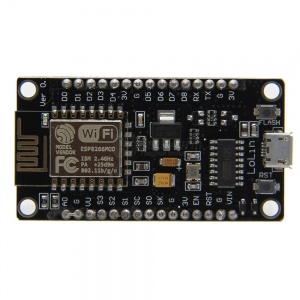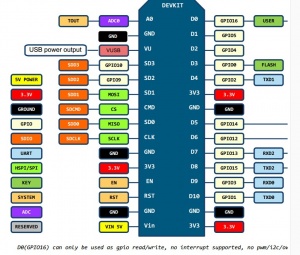NodeMcu ESP8266
Contents
overviews:
ESP8266 is a highly integrated chip designed for the needs of a new connected world.
It offers a complete and self-contained Wi-Fi networking solution, allowing it to either host the application or to offload all Wi-Fi networking functions from another application processor.
- WINDOWS driver USB to serial CH341 / CH340 installation package
- Support WINDOWS 98 / ME / 2000 / XP / Server 2003 / VISTA / Server 2008 / Win7 / Win8 / Win8.1 32 Bit / 64 and MAC
- Through Microsoft's digital signature authentication
- In the computer end of the USB device emulation as a standard serial devices Serial COM
- It contains the serial number and identification CH34X monitoring CH34X equipment swap library.
Feature:
- Wireless 802.11 b / g / n standard
- Support STA / AP / STA + AP three operating modes
- Built-in TCP / IP protocol stack to support multiple TCP Client connections (5 MAX)D0 ~ D8, SD1 ~ SD3: used as GPIO, PWM, IIC, etc., port driver capability 15mAAD0: 1 channel ADC Power input: 4.5V~9V (10VMAX), USB-powered
- Current: continuous transmission: ≈70mA (200mA MAX), Standby: <200uA
- Transfer rate: 110-460800bps
- Support UART / GPIO data communication interface
- Remote firmware upgrade (OTA)Support Smart Link Smart Networking
- Working temperature: -40 ℃ ~ + 125 ℃
- Drive Type: Dual high-power H-bridge driver
Instruction & Steps of How to use:
1. Download the Arduino IDE, the latest version.
2. Install the IDE
3. Set up your Arduino IDE as:
Go to File->Preferences and copy the URL below to get the ESP board manager extensions: arduino.esp8266.com/stable/package_esp8266com_index.json
4. Go to Tools > Board > Board Manager> Type "esp8266" and download the Community esp8266 and install.
5. Set up your chip as:
- Tools -> Board -> NodeMCU 1.0 (ESP-12E Module)
- Tools -> Flash Size -> 4M (3M SPIFFS)
- Tools -> CPU Frequency -> 80 Mhz
- Tools -> Upload Speed -> 921600
- Tools-->Port--> (whatever it is)
6. Download and run the 32 bit flasher exe at Github(Search for nodemcu/nodemcu-flasher/tree/master/ at Github)github.com/nodemcu/nodemcu-flasher/tree/master/Win32/Release Or download and run the 64 bit flasher exe at: github.com/nodemcu/nodemcu-flasher/tree/master/Win64/Release
7. In Arduino IDE, look for the old fashioned Blink program. Load, compile and upload.
8. Go to FILE> EXAMPLES> ESP8266> BLINK, it will start blinking.
Data download and firmware link
Data download access to the website: : http://www.nodemcu.com/index_en.html
Firmware link: https://github.com/nodemcu/nodemcu-firmware


Enable comment auto-refresher